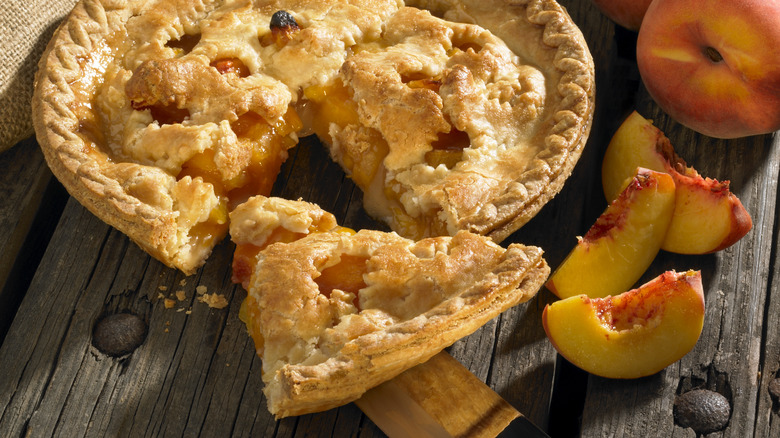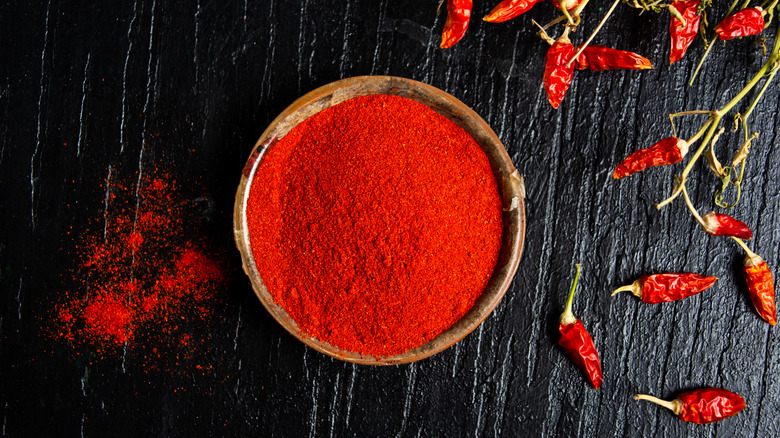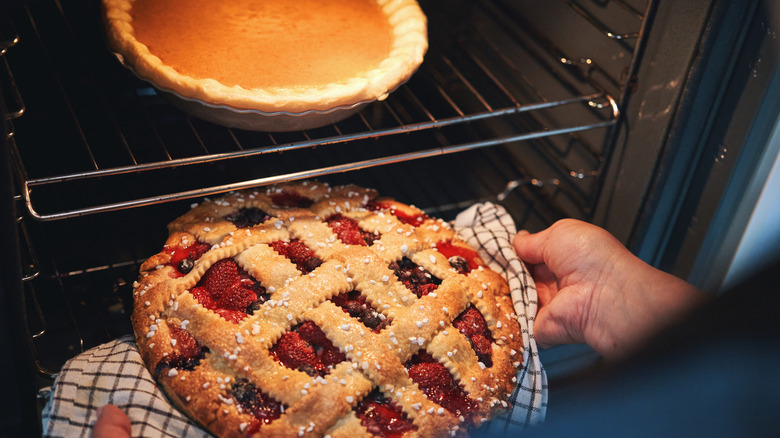The Smoky Ingredient Alton Brown Swears By For Fruit Pies
Alton Brown may have been born in California, but he more or less grew up in Georgia; in fact, he still lives there. Brown is a Southern boy; he knows a good peach pie. So if Alton Brown tells you to put smoked paprika in your peach pie, you do it.
If a record scratch just sounded in your head, that's understandable. Smoked paprika? Like, the thing you put in barbecue potato chip seasoning? Yeah, that one. In his recipe for frozen peach pie (not frozen like an ice cream cake — it's for preserving fresh peach pie filling from peach season to pumpkin spice season and beyond), Brown asks you to trust him. "Adding spices to fruity desserts," he says, "adds considerable dimension to flavors that all too often just taste plain sweet."
It's the same reason cinnamon and nutmeg go into apple pie; it's just a different version. And it's not overpowering, just a scant ½ teaspoon per 4 cups of peaches and ½ cup of sugar. It's just enough to balance the sweetness of the pie filling and offer some complexity without stealing the show. It's the kind of thing that will keep you coming back for more. It's just good eats.
The reason paprika works
Paprika is a ground spice made from dried capsicum annum peppers, generally pimento or Hungarian peppers. There are three levels of heat to paprika: Picante (hot), dulce (sweet), and agridulce (bittersweet). Smoked paprika usually comes in hot or sweet. The peppers are originally from Mexico and Central America and have been eaten there for 9,000 years, but quickly found root in Spain, Hungary, Turkey, and The Netherlands. Sometimes, traditionally done by monks in Spain, the peppers were dried in smokehouses; this gave them a smoky flavor — smoked paprika.
Smoked paprika may have the strong flavor of smoke, but that's not all it has. Paprika is bittersweet, earthy, and fruity. It's a bit tangy and citrusy from the pepper's natural citric acid. This provides a balancing tartness to the peaches' sweetness. Another prominent flavor compound in paprika, ethyl acetate, gives it a fruity note. The butteriness of a compound called isovaleraldehyde balances the tartness of the citric acid and the earthy, smoky bitterness of pyrazine compounds. These pair very well with sweet fruit flavors, like peaches, as balancing flavor agents.
Where else can you put paprika?
Don't be afraid to add smoked paprika to the established spice mix for a spiced peach pie. It also doesn't need to be relegated to peach pies. It works quite well with any stone fruit, plums especially, but also cherries, nectarines, and apricots. Perhaps your cherry pie doesn't suffer from the same one-note sweetness as a peach pie, but a touch of smoked paprika can add a deep backbone of flavor to send it out of this world.
According to James Briscone's research in The Flavor Matrix, capsicums like paprika pair well with stone fruit because of shared flavinoids. It also pairs fairly well with pomme fruits like apples, pears, and quince. Next time you're making an apple pie, try adding smoked paprika to your pie spice mix, ginger, cinnamon, and all spices that pair phenomenally with paprika. Berry pies don't pair quite as well with capsicum, but they do pair with smoky flavors. Give it a try and see if you like it. And add a bit to your next pumpkin or sweet potato pie.


